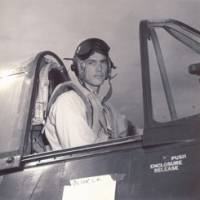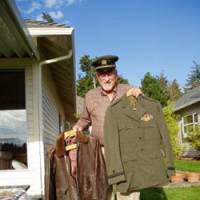From 26,000 feet he punched through a hole in the overcast over Tokyo early on a freezing Feb. 12, 1945, rolled into a roaring 60-degree dive and fired his rockets at a Mitsubishi engine plant.
As antiaircraft tracers whizzed around him, he leveled his Grumman F6F Hellcat off at rooftop level, hightailing it at 500 knots for the coast on a course plotted to get him and his formation back to their carrier, the USS Essex, waiting 500 km out in the Pacific at different coordinates from where Fighting Squadron 4, the "Red Rippers," took off. The predawn raid achieved total surprise.
The fighters' 5-inch rockets tore holes in the factory's roof. Dive-bombers then swooped in from a different vector to finish the job.
The raid Ensign Lee "Ole" Olson took part in as wingman of flight leader Lt. W.P. "Blackie" Blackwell was historic — the first on Tokyo involving carrier fighters — some 1,200 — and multiple targets.
Navigating with maps on their knees, the pilots' hit-and-run was an application of a training regimen that left little to chance. Focus, timing, concentration, clockwork. Air war by the numbers. No time for fear.
"It was a youth's game," Olson, who turns 86 this month, said recently. "We were well-prepared. And everything worked." But before he and his group could fly off the Essex's wood-planked deck, 10 cm of snow had to be shoveled off — and just weeks earlier, they had been sweltering in Philippine heat of over 30 degrees.
They attacked again the next day, hitting airfields.
Earlier, as the Essex steamed north and the crew donned more clothing, its planes raided China's Hainan Island, the Chinese coast, Formosa, Saipan and Saigon harbor of French Indochina (Vietnam), hitting oil tankers and fuel facilities critical to Japan's war effort — all surprise hits.
"The Saigon River was ink blue," Olson recalled.
Task Force 39's speed was part of the element of surprise plotted by Adm. William "Bull" Halsey.
"We always assumed every raid was a surprise," Olson said, likening the legendary naval tactician to his army counterpart, Gen. George Patton. "The sailors liked him. He wasn't a book reader. His tie was never straight and his hat was always crooked."
Three weeks before the Tokyo raid, Olson's group hit an airfield at Naha, Okinawa. Antiaircraft fire knocked off the end of Blackwell's wing, but Olson escorted the "sick chicken" back to the flattop, where the crippled Hellcat, only able to "crab" sideways, made what was described as a "spectacular crash landing." Blackwell walked away with only some scratches.
Less than a week after the Tokyo raids, Olson's group was coming in hot and low over Iwojima Island on D-day, dropping their reserve fuel tanks, packed with napalm, breaking off only when the landing marines got too close to their targets.
"We lost 5,000 marines there. They had to crawl over 6 inches of pumice," Olson said. After Pearl Harbor, "We were chasing (the Japanese) back home."
Olson was a Montana farm boy with seven sisters and two brothers when his country called him for duty Aug. 12, 1942, in the form of a draft notice.
He signed up in Seattle for naval air cadet school and reported to Gonzaga University for civilian flight training, soloing in a light plane mounted with skis in snowbound Spokane, Wash., in January.
"When we got our civil pilots' wings, we were big shots," Olson recalled.
He joined a training process designed like a ladder, step by meticulous step, ultimately earning his navy wings in Pensacola, Fla. Swimming lessons were included. "They asked if I'd ever seen water. As I was a farm boy, I said 'sure, in a horse trough.' "
Olson learned to swim long distances submerged, which he grew to enjoy. "We had to do this in case our ship was hit," he said, because of the risk of surface fires from spilled fuel oil.
Later, when his fleet came under air attack, Olson noted: "You could hear the 20 mm (pom-poms fired by outlying ships), then the 40s, then the 5-inchers when they got real close." Tense times.
After brief training in the Atlantic aboard the carrier USS Bunker Hill, Olson's group transferred to Hilo, Hawaii, to practice night and heavy weather flying — Japan-type weather. "It wasn't Tahiti," he said, noting he took (and still takes) bilberry to enhance his night vision.
The group joined the Essex, and the war, in Leyte Gulf.
Like their compatriots below, the pilots focused on the job and on looking after comrades. No flag-waving, no dwelling on the dangers. But mourning came with the turf.
"We cross-weaved, covering each other's tail for protection," Olson said, demonstrating the intersweeping technique with his arms. This was how he and Blackwell "splashed" their first "Zeke" (Zero fighter). "The Japanese would fly loner, doing aerobatics. We worked in teams."
On a November 1944 raid on Manila and Clark Airfield, Olson's pal, Ensign S.R. "Fan Tan" Tanner, had to ditch after taking heavy AA fire.
"The throttle impaled his hand on impact," Olson said. "I covered him by circling until he was safely out of his plane." Guerrillas rowed out and took Tanner into the jungle, and when malaria threatened, "native women cured him with mother's milk!"
More sobering, Olson, as the chaplain's aide, sometimes had to write the painful letters home and send dog tags. In his yearbook of sorts, he underlined the names and fate of buddies lost, some committed to the deep navy-style: a flag-shrouded ramp into the waves.
He recalled the Hawaii ground crewman who backed into a spinning prop, downed fliers who couldn't be protected, and a pilot blown up by the bomb he just dropped. "He was too low."
When not on a raid, Olson engaged in combat air patrols, flying figure-8 patterns around his fleet to provide protective cover and ward off enemy planes following fighters back to their ships. It was 11 hours with one pit stop.
A kamikaze hit the Essex's side elevator during one CAP. The crew rose to the occasion and found a boiler plate to cover the hole. "They signaled me to come home," he said, noting he always tried to tail-hook the second of the six grab wires on the 200-foot landing zone.
Then there was the time he blew a tire landing on a listing "Kaiser coffin" pocket carrier. "I later found out it was a retread."
Olson sometimes launched by steam catapult, which shot his plane from zero to 90 knots in 30 meters. "You held the stick with your right hand and tucked your right elbow tight into your gut. With your left, you applied full throttle and signaled to launch." If the elbow slipped out from the G-force and the stick was pulled back, the plane would stall, hit the sea and be run over by the carrier.
By March 20, 1945, Olson had logged 900 hours, including 700 in combat duty — time to rotate out and let new jocks in, unlike so many who had to slog out the war for the duration. He and other mission-fulfilled pilots officially ended their war upon arrival at San Diego on April Fools Day. Hitler's end was weeks away, and Japan's months.
Olson earned an Air Medal and citation for bravery signed by Navy Secretary James Forrestal, and made lieutenant junior grade.
Later, at San Francisco's Mark Hopkins Hotel, Olson was told to report to Jacksonville, Fla., to serve as carrier landing signals officer for new pilots. Brushing with history anew, baseball legend Ted Williams was his student.
By this time Olson had a wife waiting with 3-week-old daughter. It was time to put the war and flying behind and get on with life — fatherhood, university, a steady job.
Olson stayed on as a naval reservist for 18 years. His proviso: "Only call me if the new guys fail."
He was matter of fact about his foe. "The Mitsubishi plant was all wood framing . . . but after the war it was rebuilt" and became an industry titan.
Lee told his war tale as best as he could recollect. Of course, "if you tie a naval aviator's hands down, they wouldn't be able to tell stories," Olson laughed. The "Friday night dogfights" would dry up faster than the pints that fuel them.
Widowed, Olson stays active, fishing and kayaking — his favorite a 6-meter, 18-kg wood kayak he shoves atop his car. "People offer to help, but I decline. I guess when I can't lift it up anymore, it's time to hang up my paddle."
Olson on longevity: "If I'm still vertical, I'm still alive."
In this series, The Japan Times interview firsthand witnesses of Japan's march to war and ensuing defeat who wish to pass on their experiences to younger generations. This is the ninth installment of the Witness to War series. To read more, see the Witness to War archive.




